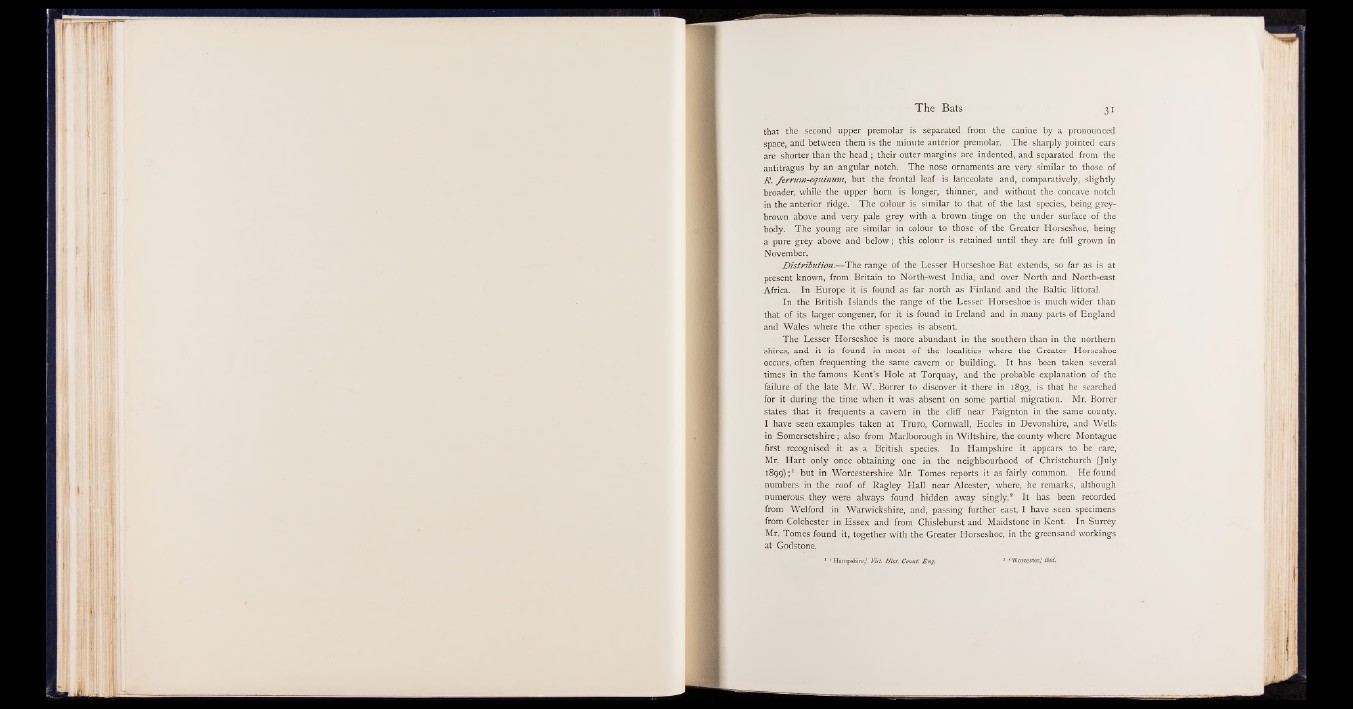
that the second .upper premolar is separated from the canine by a pronounced
space, and between them is the minute anterior premolar. The sharply pointed ears
are shorter than the head ; their outer margins are indented, and separated from the
antitragus by an angular notch. The nose ornaments are very similar to those of
R. ferrum-equinum, but the frontal leaf is lanceolate and, comparatively, slightly
broader, while the upper horn is longer, thinner, and without the concave notch
in the anterior ridge. The colour is similar to that of the last species, being grey-
brown above and very pale grey with a brown tinge on the under surface of the
body. The young are similar in colour to those of the Greater Horseshoe, being
a pure grey above and below; this colour is retained until they are full grown in
November.
Distribution.— The range of the Lesser Horseshoe Bat extends, so far as is at
present known, from Britain to North-west India, and over North and North-east
Africa. In Europe it is found as far north as Finland and the Baltic littoral.
In the British Islands the range of the Lesser Horseshoe is much wider than
that of its larger congener, for it is found in Ireland and in many parts of England
and Wales where the other species is absent.
The Lesser Horseshoe is more abundant in the southern than in the northern
shires, and it is found in most of the localities where the Greater Horseshoe
occurs, often frequenting the same cavern or building. It has been taken several
times in the famous Kent’s Hole at Torquay, and the probable explanation of the
failure of the late Mr. W. Borrer to discover it there in 1893, is that he searched
for it during the time when it was absent on some partial migration. Mr. Borrer
states that it frequents a cavern in the cliff near Paignton in the same county.
I have seen examples taken at Truro, Cornwall, Eccles in Devonshire, and Wells
in Somersetshire; also from Marlborough in Wiltshire, the county where Montague
first recognised it as a British species. In Hampshire it appears to be rare,
Mr. Hart only once obtaining one in the neighbourhood of Christchurch (July
1899);1 but in Worcestershire Mr. Tomes reports it as fairly common. He found
numbers in the roof of Ragley Hall near Alcester, where, he remarks, although
numerous they were always found hidden away singly.2 It has been recorded
from Welford in Warwickshire, and, passing further east, I have seen specimens
from Colchester in Essex and from Chislehurst and Maidstone in Kent. In Surrey
Mr. Tomes found it, together with the Greater Horseshoe, in the greensand workings
at Godstone.
‘ Hampshire,’ Viet. H ist. Count. Eng. 2 ‘ Worcester,’ ibid.